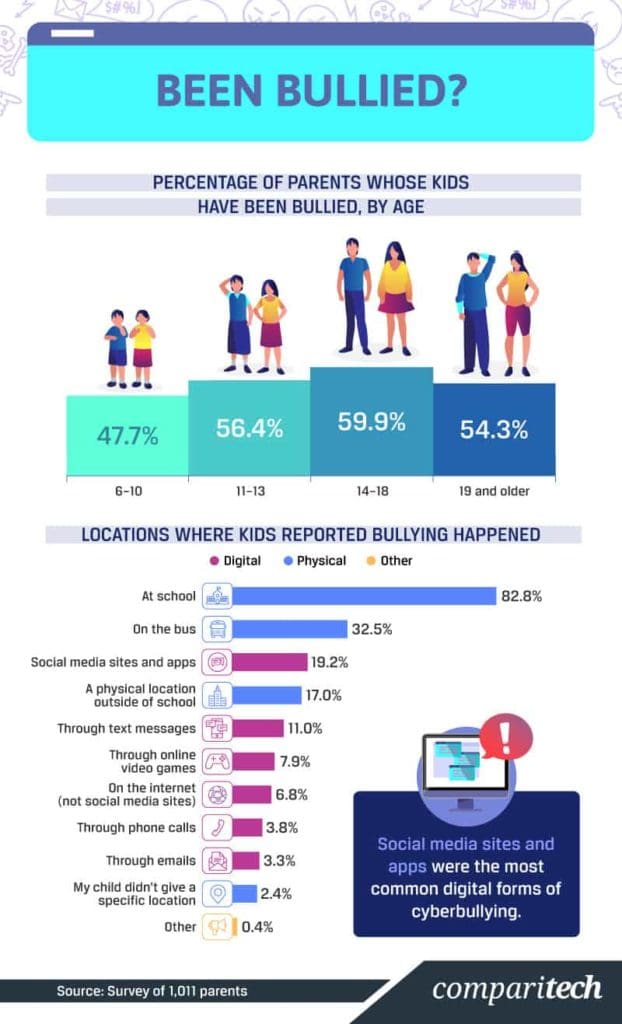Cyberbullying has been a growing problem and concern for educators and parents for years. The issue has become even more topical in the past few months as millions of students switched to remote learning and socially distanced from friends due to the coronavirus, leading to an unprecedented amount of time spent online.
With uncertainty still on the horizon regarding what the new school year will look like, whether it be in person, online, or a combination of the two, the possibility of continuing remote learning and social distancing in some capacity has a lot of parents on edge — both from a logistical standpoint and a safety one.
Natasha Tiwari, a psychologist and co-founder of education advisory firm The Veda Group, told Digital Trends that the circumstances of the lockdown “are ripe for encouraging cyberbullying.”
“Many children are at the computer for much of the day, as parents struggle to homeschool and work from home, and [this] can lead to children being more vulnerable while online,” she said.
A Parents’ Perspective
Although in school is the most common location where kids reported being bullied, nearly 20% of students are bullied on social media sites and apps, according to a report from Comparitech. 
The researchers surveyed 1,011 parents of children over the age of 5 to get their perspective on their kids’ experiences with cyberbullying. The report additionally found:
- 11% were bullied through text messages
- 7.9% were bullied through video games
- 6.8% were bullied elsewhere on the internet, excluding social media sites
- 3.3% were bullied through emails
Another study, conducted in 2018 by Pew Research, found 59% of teens experienced some form of cyberbullying, with the most common types including offensive name-calling (42%), spreading false rumors (32%), and receiving explicit images they didn’t ask for (25%).
Of the parents surveyed by Comparitech, 10.5% said they actually witnessed their kids being cyberbullied.
In response to cyberbullying, 59.4% said they talked to their children about safe internet/technology practices; 43.4% said they adjusted the controls on their children’s accounts to block the offender; 40.6% saved the evidence to assist in investigations; 34.9% notified the school; and 26.4% spoke to the parents of the child doing the cyberbullying.
Researchers also asked parents about the age of their children when they received their first technology devices such as smartphones, laptops or tablets. The average age was 9.8 years old.
The survey found children spend an average of 1.8 hours a day on their personal devices. In regards to social media sites, children ages 6-10 spend 49.6 minutes per day on them; children ages 11-13 spend 54.8 minutes per day on them; children ages 14-18 spend 72 minutes per day on them; and children 19 and over spend 72.7 minutes per day on them.
The report also found a significant discrepancy in social media platforms deemed the highest risk by parents for cyberbullying and where cyberbullying is actually occurring. Nearly 60% of parents said Facebook was the highest risk site for cyberbullying. According to a 2017 study by Ditch the Label, 42% of kids experienced cyberbullying on Instagram, outweighing Facebook, Snapchat, WhatsApp, YouTube and Twitter. Only 12.7% of parents said Instagram was the highest risk social media platform.
What Can Parents Do to Help?
While 65.8% of parents said schools should hold kids accountable for off-campus cyberbullying, the responsibility also lies with parents — especially with the current unknown future of next school year.
With so many parents stressed about having to juggle work and online learning, they may not be paying as close attention to what their kids are doing online during non-school hours. There are numerous parental monitoring tools on the market, some of which may be included on individual devices. Comparitech has detailed reviews and tutorials on parental control apps and software currently available.
Here are some other recommendations from Stomp Out Bullying on how parents can help:
- Explain that cyberbullying is harmful and unacceptable. Discuss appropriate online behavior and make it clear that there will be consequences for inappropriate behavior.
- Teach your children that if they wouldn’t say something to someone’s face, they shouldn’t say it to them online.
- Keep shared devices in the open, such as a family room or kitchen.
- Learn the social media platforms your children are using so you are able to “speak the lingo.”
- The main purpose of social media is to create a sense of connectedness and community — encourage kids to have virtual get-togethers with friends.
- Watch for signs of bullying, such as acting withdrawn or changes in sleep or appetite.
The Substance Abuse and Mental Health Services Administration also created an app for parents to “help you boost your children’s confidence, resilience, and build effective strategies for facing bullying”, according to its website. It includes conversation starters to help you begin discussions with your child/children about bullying, allows you to share successful bullying prevention strategies on social media, and much more.
Find out more information on the KnowBullying app here or check out the video below.













